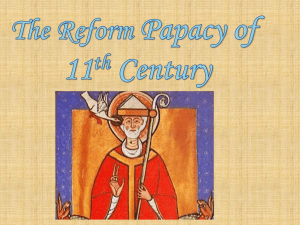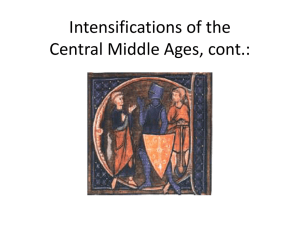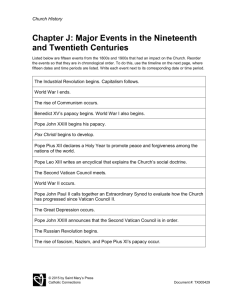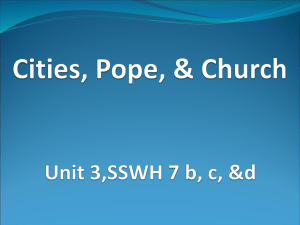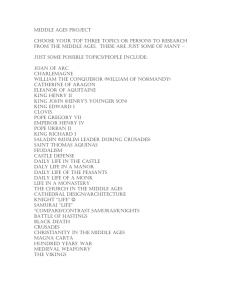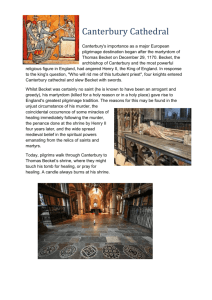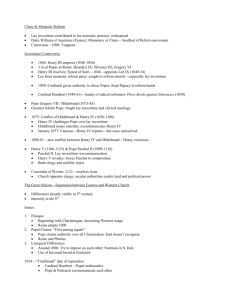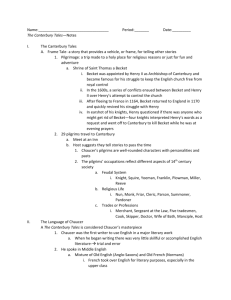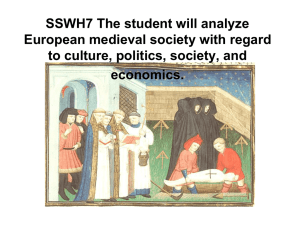A Great Cloud of Witnesses - St. Michael Catholic Church
advertisement
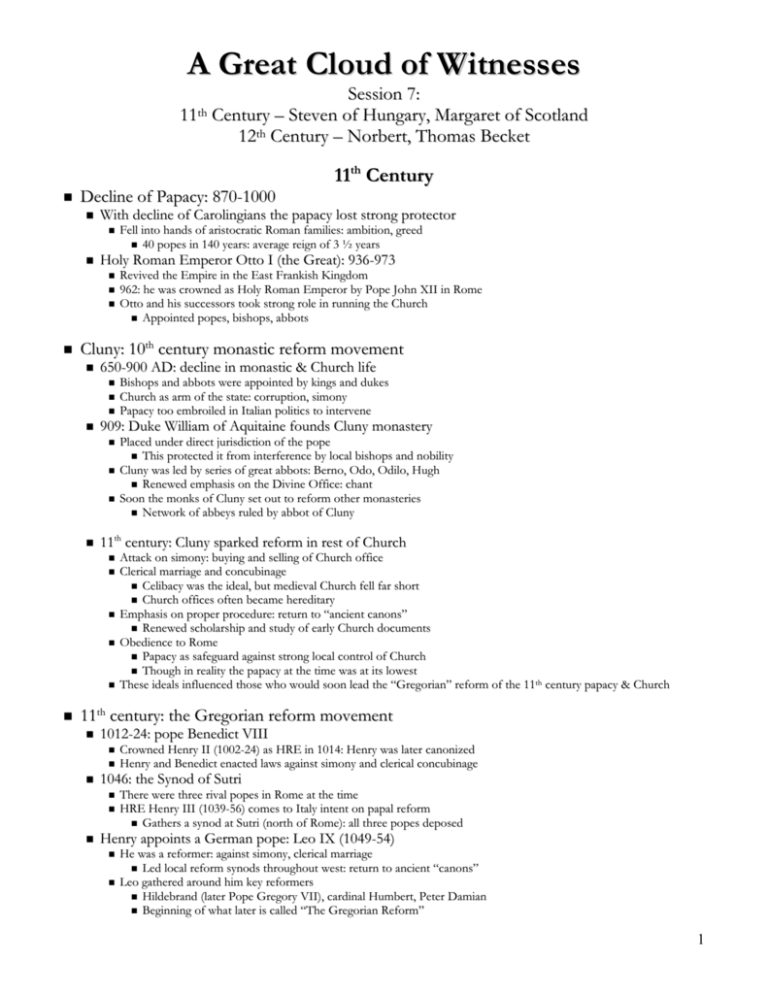
A Great Cloud of Witnesses Session 7: 11th Century – Steven of Hungary, Margaret of Scotland 12th Century – Norbert, Thomas Becket Decline of Papacy: 870-1000 With decline of Carolingians the papacy lost strong protector Revived the Empire in the East Frankish Kingdom 962: he was crowned as Holy Roman Emperor by Pope John XII in Rome Otto and his successors took strong role in running the Church Appointed popes, bishops, abbots Cluny: 10th century monastic reform movement 650-900 AD: decline in monastic & Church life Bishops and abbots were appointed by kings and dukes Church as arm of the state: corruption, simony Papacy too embroiled in Italian politics to intervene 909: Duke William of Aquitaine founds Cluny monastery Placed under direct jurisdiction of the pope This protected it from interference by local bishops and nobility Cluny was led by series of great abbots: Berno, Odo, Odilo, Hugh Renewed emphasis on the Divine Office: chant Soon the monks of Cluny set out to reform other monasteries Network of abbeys ruled by abbot of Cluny 11th century: Cluny sparked reform in rest of Church Fell into hands of aristocratic Roman families: ambition, greed 40 popes in 140 years: average reign of 3 ½ years Holy Roman Emperor Otto I (the Great): 936-973 11th Century Attack on simony: buying and selling of Church office Clerical marriage and concubinage Celibacy was the ideal, but medieval Church fell far short Church offices often became hereditary Emphasis on proper procedure: return to “ancient canons” Renewed scholarship and study of early Church documents Obedience to Rome Papacy as safeguard against strong local control of Church Though in reality the papacy at the time was at its lowest These ideals influenced those who would soon lead the “Gregorian” reform of the 11th century papacy & Church 11th century: the Gregorian reform movement 1012-24: pope Benedict VIII 1046: the Synod of Sutri Crowned Henry II (1002-24) as HRE in 1014: Henry was later canonized Henry and Benedict enacted laws against simony and clerical concubinage There were three rival popes in Rome at the time HRE Henry III (1039-56) comes to Italy intent on papal reform Gathers a synod at Sutri (north of Rome): all three popes deposed Henry appoints a German pope: Leo IX (1049-54) He was a reformer: against simony, clerical marriage Led local reform synods throughout west: return to ancient “canons” Leo gathered around him key reformers Hildebrand (later Pope Gregory VII), cardinal Humbert, Peter Damian Beginning of what later is called “The Gregorian Reform” 1 1054: the Great Eastern Schism 1059: papal election decree Secular rulers appointed bishops & abbots: powerful positions Men paid for these important positions: simony At consecration the king or duke “invested” the bishop/abbot with symbols of office: ring & crosier Looked like simony: selling of spiritual goods & offices How can a layman “invest” bishops with spiritual power? HRE Henry IV clashes with Pope Gregory VII William supported ecclesiastical reform in England But also held tight control over church appointments The lay investiture controversy Pope Nicholas II wanted to reduce secular rulers’ role in papal elections Roman synod of 1059 decreed papal election must be by “cardinal” bishops With approval and acclaim by the clergy and people of Rome Who are these cardinals? 1066: Norman invasion of England (William the Conqueror) Patriarch of Constantinople: Michael Cerularius He was very anti-western and anti-papal Denounced Latin customs: Filioque, unleavened bread, celibacy Pope Leo sends cardinal Humbert to Constantinople Humbert was hot-tempered and anti-Greek 1054: he placed a bull of excommunication on altar of Hagia Sophia Greek synod countered with its own bull of excommunication Simply the latest in long history of growing apart of East & West There would be later attempts at reconciliation Council of Lyons II (1274), Council of Basel-Florence (1431-45) Sack of Constantinople by crusaders in 1204 ended most hopes of reunion Gregory was determined to free the church from lay control Exalted view of papacy: leads to “papal monarchy” 1076: Henry denounces Gregory, who in turn declares Henry as deposed Henry kneels 3 days in snow begging absolution (Gregory relents) 1084: Henry invades Rome, Gregory dies in exile in Salerno 1123: Lateran Council I confirms compromise (Concordat of Worms) Stephen of Hungary: 975-1038 (Aug. 16) 800-950 AD: invasions of Europe from three sides Istvan (Stephen) born in 975: son of 3rd duke of Hungary Baptized at age 10 when his father became a Christian 995: Stephen married sister of HRE Henry II (St. Henry) 997: Stephen became ruler of Hungary Muslims from south, Vikings from north, Magyars from east Magyars (“Hungarians”): from central Asia In 895 arrived on the Hungarian plain: incursions into Frankish realms Finally defeated by Holy Roman Emperor Otto I in 955 Magyars were assimilated: conversion under King Stephen (d. 1038) Pope Sylvester II had a crown made and sent to Stephen Papal ambassador crowned him as first King of Hungary in 1001 Stephen founded bishoprics gradually as Magyar clergy were formed He promoted the foundation of Benedictine monasteries in Hungary Ruthlessly abolished pagan customs: prohibited marriages with pagans As fierce defender of his nation’s borders, he clashed with German emperor He had great compassion for the poor in his realm Willing to listen to the complaints of people of all ranks: even the poor He liked to distribute alms in disguise One day some beggars robbed him: he reacted with humility & humor 2 During his last years Stephen suffered a painful sickness He died Aug. 15, 1038 Paganism soon flourished again in Hungary Yet Stephen is celebrated as national hero by Hungarians Margaret of Scotland: 1045-1093 (Nov. 16) Born in Hungary in 1045 Brought high level of learning and culture Promoted reform of church in Scotland: from Celtic to more Roman She was an enthusiastic founder of monasteries Spent much of her time looking after her children and the poor Attracted by her beauty and intelligence, he married her in 1070 25 years of happy marriage Daughter Matilda married King Henry I of England Margaret transformed the Scottish court Edward hoped to make him his heir But Edward died in 1066: Normans invaded England to claim throne No longer safe for Anglo-Saxon royalty like Margaret to stay in England Margaret fled to Scotland: welcomed at court of King Malcolm III Her father was an English prince who took refuge in Hungary from Danes Married to the sister of the Hungarian king Margaret received a good education in Hungary: loved learning & culture Her father was called back to England by Edward the Confessor Also deeply devoted to prayer and reading King Malcolm relied on her advice and support: and her prayers Her own pocket edition of the gospels survives to this day Margaret fell ill from exhaustion in 1093 1083: Pope Gregory VII transferred his relics to Church of Our Lady in Buda Miracles were soon reported Stephen was canonized, and his son was beatified Stephen’s successors proved inept His only son and heir, Emeric, died in a hunting accident Many disputes over who would succeed Stephen as king She received sad news of the death of her husband and a son in battle She died Nov 16, 1093: buried with her husband at abbey of Dunfermline Devotion to her developed: canonized in 1250 by Pope Innocent IV 1560: her body (and Malcolm’s) were transferred to church in Madrid 1673: she was named patroness of Scotland The rise of the Crusades History of Christians in the Holy Land 12th Century Jerusalem and Caesarea were key patriarchal sees in East in early church Constantine built basilicas at Bethlehem & Holy Sepulcher (Jerusalem) Increasing pilgrimage to Holy Land from western Europe Arabs took Jerusalem and Holy Land in 638 AD Allowed safe passage for Christian pilgrims: for a fee Rise of Seljuk Turks in 10th century: from central Asia Converted to Islam, moved into Middle East More belligerent, less accepting of Christian pilgrims Expansion: threatened Constantinople itself in 1071 3 East appeals to West for help Council of Clermont (France), November 27, 1095 1054: mutual excommunications during Leo IX’s pontificate Bitterness, yet both sides still desired some type of reunion 1094: Emperor Alexius Comnenus appeals to Pope Urban II He simply wanted help in pushing back the Seljuk Turks Pope wanted to recover for Christendom the Holy Land Also, desire to direct knightly warfare outward Pope Urban II preaches the First Crusade Deus volt (“God wills it”): OT notion of “Holy War” Nobles should give up inner strife, turn against “infidels” Complete remission of sins for death in battle: “indulgence” After the council, popular preachers spread Crusade idea all over Europe Sad stories of fervent Christians persecuting and killing Jews The First Crusade: 1096-99 Crusaders arrived in Constantinople in 1096: Emperor quickly moved them on June of 1099: siege of Jerusalem Terrible bloodbath ensued: defenders and civilians were massacred Jews and Moslems were slaughtered, women raped Victors set up “Crusader kingdoms”: local fiefs 1128: establishment of Knights Templar, military religious order 1144: Edessa was retaken by the Turks Popular preachers stirred Europe to respond: Bernard of Clairvaux 2nd Crusade: repeatedly defeated by the Turks, accomplished little 1187: Jerusalem fell to Saladin of Egypt 3rd Crusade: led by Frederick Barbarossa (Germany), Richard the Lion-heart (England), and Philip II (France) Accomplished little 1st Crusade was the only one that was a “success” Crusading impulse would continue until circa 1300 Monastic reform: the Cistercians (“White Monks”) 1098: foundation of monastery at Citeaux Key moment was arrival of Bernard (1090-1153) in 1112 Purpose of restoring Rule of St. Benedict in all its rigor 1115: Bernard was sent to found new abbey at Clairvaux Famous preacher: more emotional faith, devotion to Mary Became the key ecclesiastical figure of his time Helped found the Knights Templar: French military order 1134: Innocent II commissioned Bernard to preach the Second Crusade Norbert, bishop & founder: 1080-1134 (June 6) 1080: born of German noble family in Xanten Related to both the German Emperor and the Guise family of Lorraine Like many sons of nobility he received minor orders: source of revenue Became a “canon” at the cathedral Yet he refused the bishopric of Cambrai No desire to become a priest: he enjoyed the “wild life” of young nobles 1115: thrown off his horse in a violent thunderstorm This was his moment of conversion: like St. Paul Made retreat at a monastery: time of prayer, fasting, and review of his life He was ordained as a priest: desire to lead an “evangelical & apostolic life” Tried to reform his brother canons, but they drove him out of town 4 So he gave away most of his wealth: went to Pope Gelasius II 1120: he founded the Order of the Premonstratensians With Bernard of Clairvaux he supported Pope Innocent II’s cause Convinced HRE Lothair to lead army to Rome support Innocent II In return the pope made him metropolitan of all east Germany & Poland He died in 1134: his remains are in Norbertine abbey in Bohemia Entered the city barefoot: porter at episcopal palace mistook him for a beggar He undertook a major reform of the archdiocese Fought against lay investiture: this made him many enemies Narrowly escaped assassination a few times Zeal for reformation of the clergy: sometimes replaced them with members of his own order 1130: helped to heal the papal schism in Rome In the poor valley of Premontre in northern France Gathered disciples: they wore a white habit and kept Rule of St. Augustine The movement spread: male and female communities 1126: Pope Honorius II officially approved the new order (O.Praem.) 1126: he was appointed as Archbishop of Magdeburg The pope gave him permission to preach wherever he wanted He traveled as itinerant preacher & reformer in northern France Tried to reform the Canons Regular at St. Martins in Laon: they resisted Canonized by Pope Gregory XIII in 1582 Thomas Becket, bishop & martyr: 1118-1170 (Dec. 29) Born in 1118 in London: son of Normans 1146: he became assistant to Theobald, archbishop of Canterbury He fled to France for the next 6 years: appealed to Pope Alexander III Negotiations between Henry, the pope, and Becket dragged on 1170: in Becket’s absence, the archbishop of York crowned Henry’s son as heir This was clear usurpation of rights of see of Canterbury 1170: Becket met with King Henry II in northern France The king wanted Thomas to end resistance of Church to royal power Thomas predicted a clash of interests from the very beginning He soon reformed his lifestyle: prayer, simplicity, almsgiving Took special care for selection of candidates for holy orders Conflicts with the king increased Resisted paying taxes to the king on church lands and having clerics tried in royal courts King demanded Thomas return to the crown his earnings as chancellor Thomas weakened in his resistance: signed the Constitutions of Clarendon Yet he soon repented of this: sought absolution from the pope 1165: Becket was tried & condemned at royal court at Northampton He made Becket his chancellor: they became close friends Enjoyed the entertainments of his position: but also generous to the poor 1159: he even fought in military expedition in northern France At this time, Becket generally was on the king’s side: sometimes against the interests of the Church 1162: Henry appointed Becket as archbishop of Canterbury 1154: he was ordained as archdeacon of Canterbury He was sent to Rome: secured papal approval of succession of Henry II 1155: Henry II was crowned as king of England Educated at Merton Abbey in Surrey He agreed to return to England: “I am going home to England to die” Becket was received in England by the people: but key nobility resisted Dec. 25: Becket denounces Archbishop of York from his pulpit This enraged the king, his heir, some bishops, and key nobility In fit of rage Henry II asked who would rid him of Thomas 5 Dec. 29, 1170: four knights arrived at the cathedral in Canterbury Thomas had not lived like a saint, but he died like one He sought sanctuary in the church: but the knights burst in during vespers Knights: “Where is Thomas the traitor?” Becket: “Here I am; no traitor, but archbishop and priest of God” He was hacked to death by the knights in front of the altar The assassination provoked universal horror in England and the Continent Henry II expressed extreme grief at the news 1172: he did public penance and received absolution from the pope Miracles were soon reported by those who visited Becket’s tomb 1174: Thomas Becket was canonized by Pope Alexander III His shrine in Canterbury Cathedral was popular pilgrimage sight throughout the Middle Ages: Geoffrey Chaucer’s “Canterbury Tales” The Pilgrim’s Way from London to Canterbury can still be traced Some 80 churches in England were named after Thomas Becket 1538: King Henry VIII destroyed the shrine during his own rebellion against the papacy 6
